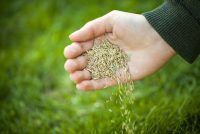Winter Lawn Seeding: A No-Work Method
No one likes to see bare and thin areas on their lawn when spring comes. Chances are that you didn’t have the time or energy to seed in the fall, and you probably would rather not deal with it in the spring when you will already have enough to do in the yard. The answer? No-work Winter Lawn seeding.

Winter lawn seeding is the lazy (or busy!) person’s way to fill in bald or thin spots on northern lawns with very little effort. It also can be used to introduce newer, better grasses to an old lawn, without any heavy raking or shoveling.
Winter seeding is best done after mid-winter, perhaps mid-February to mid-March, so if you’re reading this when we post it (late January) there is still plenty of time to get some seed if you don’t have any already.
Whenever you decide to do the winter seeding, you’ll need to wait for a thaw so you can easily see the areas of the lawn that are now bare, dog damaged, or thinner than you’d like. When the snow melts and you can see these areas, simply sprinkle some grass seed fairly heavily right over the soil on the thin or bare grass areas, and that’s that. You can also spread seed over any sections of the lawn that you want to improve with newer, perhaps greener, shade tolerant, or more durable grass types.
Once you’ve spread the seed, the next month or two of freezing and thawing of the soil, along with the water penetration from snow and rain will work the seed into the soil deep enough to keep it moist and protected. This seed should sprout by mid-spring. It may not be quite as effective as conventional seeding during warmer months, but it is fast, easy, and definitely worth a try.
NOTE: If you have 1/2 inch or more of a matted thatch layer, winter seeding probably won’t work. You will want to handle that thatch ASAP when warmer weather arrives to make sure your spring lawn doesn’t develop fungus or disease as the temperatures change. Try our Biological Dethatcher to effortlessly break down your thatch layer into beneficial compost.
In the South and warmer transitional states, or the Pacific NW, you can also use this time to your advantage by continuing to improve your soil. This can be done even if the grass and gardens are not actively growing. As long as daytime temperatures are generally not close to freezing, soils are quite bio-active and will respond easily to beneficial amendments. Apply Aerify PLUS to improve compacted or clay soils, or use the Nature’s Magic for sandy or loose soils, or to build up organic matter in the lawn or garden. Over the winter the soil in warmer climates can improve structure, aeration and beneficial microbial growth. When the grass and other plants start to re-grow in the spring, they will get off to a much better start in an improved soil.


